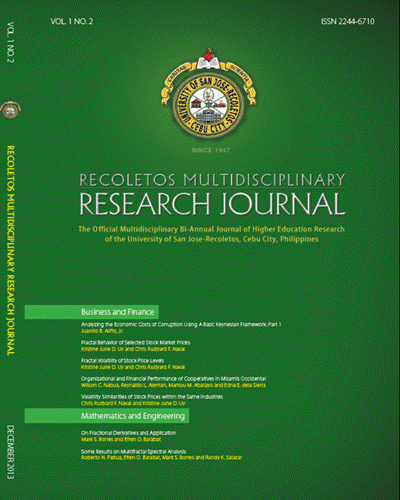The Density of Primes Less or Equal to a Positive Integer up to 20,000: Fractal Approximation
DOI:
https://doi.org/10.32871/rmrj1301.02.21Keywords:
density of primes, prime number theorem, multifractal distribution AMS classification, number theory, applied mathematicsAbstract
The highly irregular and rough fluctuations of the number of primes less or equal to a positive integer x for smaller values of x ( x≤20,000) renders the approximations through the Prime Number Theorem quite unreliable. A fractal probability distribution more specifically, a multifractal fit to the density of primes less or equal to x for small values of x, is tried in this study. Results reveal that the multifractal fit to the density of primes in this situation outperforms the Prime Number Theorem approximation by almost 200% viz. the
prediction error incurred by using the PNT approximation is double that of the multifractal fit to the density of primes. The study strongly suggests that a better multifractal distribution exists, even for large x, than the Prime Number approximation to the density of primes.
References
D. J. Newman (1980). “Simple analytic proof of the prime number theoremâ€. American Mathematical Monthly 87 (9): 693–696.
Glaisher, J. W. L.(1891) “On the Sums of Inverse Powers of the Prime Numbers.†Quart. J. Math. 25, 347-362.
Graybill, W. (1980). General Linear Models. (Wiley Series, NY)
Hardy, G. H. & Littlewood, J. E. (1916). “Contributions to the Theory of the Riemann Zeta-Function and the Theory of the Distribution of Primesâ€. Acta Mathematica 41: 119–196.
Ingham, A.E. (1990). The Distribution of Prime Numbers. Cambridge University Press. pp. 2–5.
Merrifield, C. W. (1881)â€The Sums of the Series of Reciprocals of the Prime Numbers and of Their Powers.†Proc. Roy. Soc. London 33, 4-10.
Nils (2009) “Formalizing an analytic proof of the Prime Number Theoremâ€. Journal of Automated Reasoning. volume 43, pp. 243––261.
O. Shanker (2006). “Random matrices, generalized zeta functions and self-similarity of zero distributionsâ€. J. Phys. A: Math. Gen. 39 (45): 13983–13997.
Padua, R, Palompon, D and Ontoy, D. (2012). “Data Roughness and Fractal Statistics†(CNU Journal of Higher Education, CHED-JAS – Category A, Vol. 6, No. 2).
Pierre Dusart (1999). “The kth prime is greater than k(ln k + ln ln k−1) for k ≥ 2â€. Mathematics of Computation 68: 411–415.
Tao, Terence (2007) “Video and slides of Tao’s lecture on primesâ€, UCLA January 2007.
Downloads
Published
How to Cite
Issue
Section
License
Copyright of the Journal belongs to the University of San Jose-Recoletos


